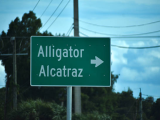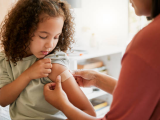Apr 1, 2010 (CIDRAP News) – Federal health officials estimated today that 24% to 27% of Americans, or 72 million to 81 million people, had received a dose of 2009 H1N1 vaccine by the end of February, with coverage varying widely from state to state.
Estimated vaccine uptake ranged from a low of 12.9% in Mississippi to a high of 38.8% in Rhode Island, the Centers for Disease Control and Prevention (CDC) reported in Morbidity and Mortality Weekly Report (MMWR).
By demographic group, children had the highest coverage at 36.8%, well above past coverage levels for seasonal flu vaccine, the CDC said. The overall estimate for adults was 20.1%, and the estimate for those initially targeted for vaccination because of their risk status was 33.2%, the agency said.
At a news briefing on the estimates today, Dr. Anne Schuchat of the CDC said state-to-state differences in coverage may have had to do with the timing of the fall peak of H1N1 cases, among other factors. The vaccine was still in limited supply when cases peaked in much of the country in late October and early November.
"We all know that if we had had more vaccine available, more people would've received vaccine and we would've prevented more disease," said Schuchat, director of the CDC's National Center for Immunization and Respiratory Diseases.
The CDC estimated in March that about 59 million Americans were infected with the pandemic virus, 265,000 were hospitalized, and 12,000 died.
Two surveys used
The CDC combined data from two different surveys to come up with its estimates. One is the Behavioral Risk Factor Surveillance System (BRFSS), an ongoing state-based telephone survey of about 400,000 adults, which included questions about H1N1 vaccination starting last October. The other is the National 2009 H1N1 Flu Survey (NHFS), which was launched in October and continues through June.
The CDC averaged the results of the two surveys through January to come up with the coverage estimates for the states. Schuchat said a total of 214,316 people responded to the surveys.
The agency included February data from the surveys to estimate national vaccine coverage. By combining data from both surveys, the CDC estimated national uptake at 24.0% (95% confidence interval [CI], 23.4% to 24.6%), or 72 million people. The NHFS data alone yielded an estimate of 27.1% (95% CI, 25.9% to 28.3%), or 81 million people.
The CDC estimated that between 81 million and 91 million doses of vaccine, out of 229 million ordered, have been administered. Two doses were recommended for children under the age of 10, with one dose advised for everyone else.
Coverage differences among the states were widest for children. The estimates ranged from 21.3% in Georgia to 84.7% in Rhode Island, with a median of 36.8%. Uptake in children was higher than in adults for all states.
For adults overall, the vaccination rate was estimated at 20.1%, with state rates ranging from 8.7% to 34.4%. The national estimate for those in the initial target groups, 33.2%, reflected a state range of 19.4% to 57.5%. The target groups consisted of pregnant women, healthcare and emergency medical workers, children and young people from 6 months to 24 years, 25- to 64-year-olds with high-risk medical conditions, and people caring for infants younger than 6 months.
National estimates and state ranges for other demographic groups included:
- 25- to 64-year-olds with underlying medical conditions, 25.2% (10.4% to 47.2%)
- Healthy 25- to 64-year-olds, 14.4% (6.1% to 24.6%)
- People 65 and older, 22.0% (8.9% to 43.8%)
Discussing the state variation in coverage, Schuchat said four New England states, Rhode Island, Vermont, Massachusetts, and Maine, did "an incredible job," with all achieving better than 60% coverage in children.
"Three of the four carried out school vaccinations," she said. "I think there's a compelling story, and it's something we'll be investigating more fully."
Schuchat said it's too soon to know why some states did much better than others. But one possible factor that helped New England was that vaccine was in good supply by the time H1N1 cases were cresting in early November, she said. In contrast, she said the peak came earlier in Georgia, when doses were in shorter supply. The state had estimated coverage of only 16.6% overall, near the low end nationally.
Schuchat said about 40 states had programs to vaccinate children at school. "It may be that some of those had an easier time implementing their plans" than others, she said, later noting that Maine and Rhode Island were particularly "aggressive" in their school-based vaccination efforts.
"I don't have specifics about lower-coverage states and whether they did school-based vaccination," she said in response to questions.
The CDC report says most states succeeded in vaccinating more children against pandemic H1N1 than they did against seasonal flu in past years. About 30% of children were vaccinated for seasonal flu in 2008-09, well below the 36.8% coverage for the H1N1 vaccine, it states.
For younger adults with high-risk conditions, seasonal flu vaccination coverage has typically ranged from 25% to 30%, which is in the same ball park as the 25% uptake seen with the H1N1 vaccine, Schuchat observed.
She said it's likely that some of the H1N1 vaccine will go unused but declined to specifically endorse the estimate in a Washington Post report today that 71.5 million doses may be thrown out.
"It's unlikely that all the doses will be used up, but we made a conscious decision to have more than enough vaccine" rather than risk having too little, she said.
The Post report said that about 138 million doses out of the 229 million ordered remain unused, based on the estimate that 91 million doses have been administered so far. The CDC has said that 162.5 million doses were finished and released for use so far. The Post story suggested that the 71.5 million doses still unused may go to waste. Without citing specific sources, the story also said about 25 million doses are being given to poor countries and about 35 million remain in bulk form and therefore have a longer shelf life.
When asked about the report, Schuchat commented, "It's very difficult to say how many doses of vaccine will go unused and be discarded. What I can say is that every year with the seasonal flu vaccine effort some vaccine is discarded. It would be a surprise if we didn't see greater numbers go unused this year than with seasonal."
Schuchat said it is "theoretically possible" that some of the vaccine still in bulk form could be used in the 2010-11 seasonal flu vaccine, which will include an H1N1 component. The possibility is being discussed at the Department of Health and Human Services and vaccine companies, she added. The bulk vaccine will be good until next year, the CDC has said.
CDC. Interim results: state-specific influenza A(H1N1) 2009 monovalent vaccination coverage—United States, October 2009-January 2010. MMWR 2010 Apr 2;59(12):363-8 [Full text]


















